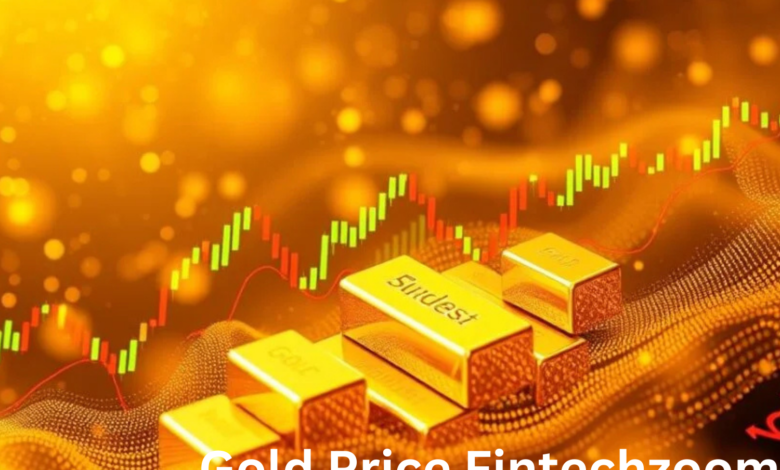The Impact of Market Changes on Gold Price Fintechzoom Perspective

Gold Price Fintechzoom has long been a symbol of wealth and prosperity, capturing the imagination of investors and collectors alike. As a precious metal with a rich history, its value fluctuates based on various market forces. Yet, in today’s fast-paced economic landscape, understanding the intricacies behind gold prices is more vital than ever.
The impact of market changes on gold price cannot be overstated. With shifts in global economies, interest rates, and geopolitical tensions constantly at play, staying informed is crucial for anyone looking to invest wisely. Enter Fintechzoom—a platform that sheds light on these dynamic trends within the gold market.
This blog will explore how past events shaped today’s gold price landscape while examining key factors influencing fluctuations. We’ll also delve into how fintech innovations are reshaping investment strategies before considering current market changes and what they mean for future investments in this enduring asset class. Are you ready to uncover the multifaceted world of gold? Let’s dive in!
The History of the Gold Price and Market Trends
Gold has been a symbol of wealth for centuries. Its value transcends cultures and eras, making it an enduring asset in human history.
In ancient times, gold was used as currency and a means of trade. Civilizations like the Egyptians and Romans recognized its intrinsic value early on. The allure of gold only grew with time.
Fast forward to the 20th century, where we saw fluctuations driven by economic events such as wars, inflation, and financial crises. In 1971, the end of the Bretton Woods system marked a pivotal change in how gold prices were determined.
Market trends have since become influenced by various factors including geopolitical tensions, interest rates, and changes in demand from emerging markets. Each period brings new dynamics that shape investor sentiment toward this precious metal.
Today’s market continues to reflect these historical shifts while adapting to modern forces like technology and global trading practices.
Factors that Influence Gold Prices
Gold prices are influenced by a multitude of factors. Geopolitical tensions often drive investors toward gold as a safe-haven asset. When uncertainty looms, demand typically increases, pushing prices higher.
Economic indicators also play a crucial role. Inflation rates and currency fluctuations can sway the value of gold significantly. A weaker dollar usually translates to higher gold prices since it becomes cheaper for foreign investors.
Additionally, interest rates have an inverse relationship with gold values. Lower interest rates reduce the opportunity cost of holding non-yielding assets like gold, making them more attractive to investors.
Supply and demand dynamics are essential too. Mining production levels and central bank reserves influence market availability and pricing strategies.
Investor sentiment cannot be overlooked. Market psychology drives trading behaviors that impact price movements in unpredictable ways.
The Role of Fintech in the Gold Market
Fintech has revolutionized the Gold Price Fintechzoom market, making it more accessible than ever. Innovative platforms allow investors to buy and sell gold with just a few taps on their smartphones. This convenience attracts a new generation of traders.
Blockchain technology is another game-changer. It enhances transparency by providing a secure ledger for transactions. This reduces fraud risks and builds trust among investors.
Moreover, fintech enables fractional ownership of gold assets. Instead of purchasing an entire bar, individuals can invest in smaller portions. This lowers the entry barrier for many potential investors.
Additionally, real-time data analytics help traders make informed decisions. With insights into market trends and price fluctuations at their fingertips, they can act swiftly to capitalize on opportunities.
As fintech continues to evolve, its influence in the gold market will likely expand further, shaping how people perceive and interact with this precious metal.
Impact of Current Market Changes on Gold Prices
Current market changes significantly affect gold prices. Economic uncertainty and geopolitical tensions often drive investors toward safe-haven assets, with gold being a prime choice.
Inflation is another critical factor influencing the price of gold. As central banks adjust interest rates to combat rising inflation, the value of fiat currency fluctuates. This scenario tends to increase demand for gold as a hedge against diminishing purchasing power.
Additionally, shifts in global supply chains can impact availability. Disruptions from trade policies or natural disasters can reduce mining output, leading to higher prices when demand remains constant or increases.
Market sentiment also plays a role. Investors closely watch stock market performance and economic indicators, adjusting their portfolios accordingly. A bearish stock market often sees an uptick in gold investments as people seek stability amidst volatility.
Understanding these dynamics helps investors navigate the complexities surrounding current trends in the gold market.
Expert Predictions for the Future of Gold Prices
Experts hold varied views on the trajectory of gold prices in the coming years. Some analysts predict a bullish trend, citing increasing geopolitical tensions and economic uncertainty as driving factors. As investors seek safety, demand for gold could spike.
Conversely, others suggest that a strengthening U.
S. dollar and rising interest rates might put downward pressure on prices. They argue that investors may pivot to stocks or bonds if yields become more attractive.
Technological advancements in trading and investment platforms are also expected to influence market dynamics. Increased access to gold through fintech solutions can lead to higher participation from retail investors.
Additionally, inflation concerns remain pivotal. If inflation continues unchecked, many believe it will bolster gold’s appeal as an inflation hedge. The interplay between these variables makes forecasts complex yet fascinating for those watching the market closely.
Conclusion: Is Investing in Gold Still a Viable Option?
Investing in Gold Price Fintechzoom has long been considered a safe haven. Its allure remains strong, especially during times of economic uncertainty and market volatility. Historically, gold acts as a hedge against inflation and currency devaluation. However, the dynamics influencing its price have evolved.
Current market changes present both challenges and opportunities for investors. The interplay between global demand, geopolitical tensions, and emerging fintech solutions is reshaping how we view this precious metal.
For those contemplating investing in gold today, it’s essential to remain informed about these trends. Balancing traditional investment strategies with modern technological advancements can offer new avenues for wealth preservation.
Whether one chooses to invest in gold will depend on individual financial goals and risk tolerance amid ongoing market fluctuations. Gold may still hold its value as an asset class but requires careful consideration in today’s rapidly changing landscape.




